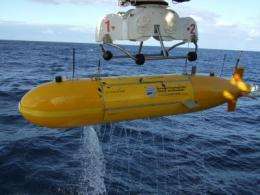The robot submarine Autosub6000 can dive 3.73 miles (6,000 m) deep and was developed at the National Oceanography Centre, Southampton. Credit: NOCS
A British scientific expedition is heading into the world's deepest volcanic rift, more than three miles beneath the waves in the Caribbean, to hunt for the deepest "black smoker" vents detected so far on the ocean floor. The team, working aboard the Royal Research Ship James Cook, will use a robot submarine called Autosub6000 and a remotely-controlled deep-sea vehicle called HyBIS to reveal the features and inhabitants of the world's undersea volcanoes for the first time.
The expedition is being run by Drs Doug Connelly, Jon Copley, Bramley Murton, Kate Stansfield and Professor Paul Tyler, all from the National Oceanography Centre in Southampton, UK. They will explore the Cayman Trough - a rift in the seafloor of the Caribbean that reaches more than three miles deep. In November last year, a US-led survey of the waters of the Cayman Trough detected signs of deep-sea vents on the ocean floor below - and now the British expedition is heading out to investigate them.
Deep-sea vents are undersea volcanic springs that erupt mineral-rich water hot enough to melt lead. They were discovered in the Pacific three decades ago, but most are found one to two miles deep, dotted along chains of undersea volcanoes around the world. Scientists are fascinated by these vents because they support lush colonies of deep-sea creatures that thrive in the otherwise sparsely-populated abyss. The vent creatures feed on microbes that are nourished by minerals in the superheated water, creating an ecosystem that is not reliant on sunlight as its energy source.
For this expedition, the RRS James Cook is equipped with Autosub6000, a robot submarine developed by engineers at the National Oceanography Centre in Southampton, UK. Autosub6000 can dive 3.73 miles (6000 m) deep to map the ocean floor in detail, survey the currents and chemistry of deep waters, and take photographs. The team also plan to use a deep-sea vehicle called HyBIS, built by engineering company Hydro-Lek Ltd in Berkshire, UK. HyBIS can be remotely-controlled from the ship to film the ocean floor and collect samples of rocks and deep-sea creatures.
The researchers hope to compare the marine life at the bottom of the Cayman Trough with that known from other deep-sea vents, thereby shedding light on the web of life that spans the deep ocean. "Studying the species that thrive in such unlikely havens gives us insights into patterns of marine life around the world, and even the possibility of life on other planets,", says Copley, a marine biologist at the University of Southampton and leader of the research programme.
In addition, the team will investigate the geology of the area and the hot water that gushes from deep-sea vents. "Because deep-sea vents get hotter at greater depths, we expect these vents to be the hottest yet," says geochemist Connelly, who will be the Principal Scientist aboard the ship. The current world-record temperature for a deep-sea vent is 403ºC, at a vent 2.67 miles (4300 metres) deep in the middle of the Atlantic.
The expedition will also leave instruments on the ocean floor to monitor the little-known deep-sea currents of the Cayman Trough, and deploy experiments to investigate how deep-sea creatures colonise new habitats. The scientists will board the RRS James Cook in Trinidad on 21st March, to prepare for the ship's departure on 25th March. The expedition is scheduled to arrive at the Cayman Trough around 31st March, and will end in Jamaica on 24th April. During the voyage, the scientists will be posting updates about their progress live from the ship at www.noc.soton.ac.uk "We look forward to sharing the excitement of our expedition with people around
the world", says Copley.
Provided by National Oceanography Centre, Southampton






















